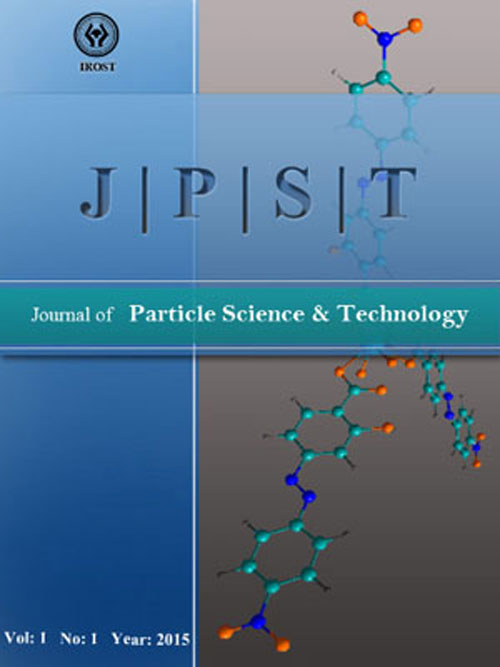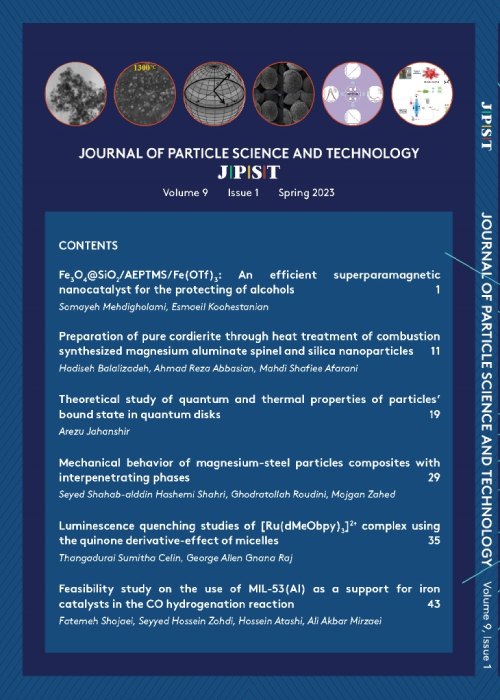فهرست مطالب

Journal of Particle Science and Technology
Volume:1 Issue: 3, Summer 2015
- تاریخ انتشار: 1395/04/10
- تعداد عناوین: 6
-
-
Pages 129-140In this article various pipes used for transporting of gas are introduced and pros and cons of each one are elucidated. The pipes are categorized in three different subgroups including metallic, polymeric and metallic-wire reinforced polymeric pipes. Metallic-wire reinforced polymeric pipes are nominated as the best option for usage in high pressure pipelines transporting natural gas. As a result, some information about major manufacturers of this kind of polymeric pipes, raw material, production process and metallic-wire orientation are presented. Finally, from economical point of view, some calculations are done to estimate required amount of polymer and metallic-wire to manufacture such pipes. It is also possible to compare their manufacturing cost with usual metallic and polymeric pipes.Keywords: different pipes, Gas transportation, high pressure, reinforced polyethylene, metal wire
-
MHD Three-Dimensional Stagnation-Point Flow and Heat Transfer of a Nanofluid over a Stretching SheetPages 141-151In this study, the three-dimensional magnetohydrodynamic (MHD) boundary layer of stagnation-point flow in a nanofluid was investigated. The NavierStokes equations were reduced to a set of nonlinear ordinary differential equations using a similarity transform. The similarity equations were solved for three types of nanoparticles: copper, alumina and titania with water as the base fluid, to investigate the effect of the nanoparticle volume fraction parameter (ϕ), the magnetic parameter (M), the Prandtl number (Pr) and the velocity ratio parameter (ε) on the flow and heat transfer characteristics. The skin-friction coefficient and Nusselt number as well as the velocity and temperature profiles for some values of the governing parameters were presented graphically and discussed. Effects of the solid volume fraction on the flow and heat transfer characteristics were thoroughly examined. It was observed that, for all three nonoparticles, the magnitude of the skin friction coefficient and local Nusselt number increases with enhancement in the nanoparticle volume fraction (ϕ). In addition, the velocity of fluid increases by increasing M and ε and the temperature increases by decreasing M, ε and Pr. The highest values of the skin friction coefficient and the local Nusselt number were obtained for the Cu nanoparticles compared to Al2O3 and TiO2.Keywords: Nanofluid, Nanoparticles, Stagnation, point flow, MHD, Stretching plate
-
Pages 153-162Calcium carbonate is a versatile mineral with diverse industrial applications. Drying is a necessary processing step in preparation of calcium carbonate product. Deep knowledge of drying kinetics is required in order to design an appropriate dryer. The main aim of the present study was to investigate the drying kinetics of calcium carbonate, experimentally. Thirteen empirical correlations with temperature-dependent constants were used to describe the thin-layer drying behavior of calcium carbonate. The correlation fitting results revealed that all examined empirical correlations were acceptable. But, the Page correlation was in the best agreement with experimental data. The effective moisture diffusivity was calculated within 8.61 × 10-9 to 10.40 × 10-9m2s-1 in the temperature range of 60 to 90˚C. The drying activation energy was also calculated to be 6.306 kJmol-1. The fitted correlations for the drying kinetics of calcium carbonate can be used to design an industrial dryer and also to estimate drying time in various drying conditions.Keywords: Calcium carbonate, Effective moisture diffusivity, Thin, layer drying, Drying rate, Empirical correlation
-
Pages 163-170Polyaniline (PANI) nanocomposite has been successfully prepared in aqueous media by the chemical polymerization of aniline with ammonium peroxydisulphate as an initiator in the presence of a steric stabilizer such as sodium dodecylbenzenesulfonate (DBSNa), Poly(vinyl pyrrolidone) (PVP), poly(vinyl alcohol) (PVA), poly(ethylene glycol) (PEG) and hydroxypropylcellulose (HPC). The chemical structure, morphology, thermal stability and thermal degradation of the synthesized PANI nanocomposite were studied by different techniques such as fourier transform infrared spectroscopy (FTIR), scanning electron microscope (SEM), X-ray diffraction (XRD) and four-probe. The results revealed that surfactant dispersed uniformly in polyanilin matrix and made a nanocomposite with average crystallite size about 74 nm.Keywords: Nanocomposite, Conductive polymer, Surfactant, Morphology, Chemical structure
-
Pages 171-182Understanding the relationship between processing parameters of fluidized bed wet granulation and the characteristics of intermediate and final products is crucial in the pharmaceutical processes. This research examined a fluidized bed wet granulation process containing a cornstarch solution as binder and lactose particles as powder. The design of experiment (DoE) was performed according to an L9 Taguchi method with three replications. The variables considered in the experimental design were binder flow rate, drying air temperature, spraying pressure, and initial mass of particle. The physical properties of the granules were evaluated in terms of granule mean size and granule size uniformity. A predictive model for each individual response was proposed. In addition, optimum conditions for each response were also obtained. Finally, the effect of the granule mean size on the flowability of granules was also investigated.Keywords: Fluidized Bed Granulation, Taguchi Method, Granule Mean Size, Size Distribution, Flowability
-
Pages 183-193In this study, several examples of hydrogels and nanocomposite hydrogels based on PVP with different content of montmorillonite nanoclay were prepared. Then, the swelling of hydrogels and kinetics of drug delivery of hydrogel in an environment similar to the body (pH 7.4) were examined. The effect of nanoparticle different percentages on the hydrogel was clearly observed. Then kinetics of drug (Isoniazid) delivery for various samples of hydrogel with nanoparticles and without nanoparticles were obtained via Peppas and Higuchi models. The comparison of Peppas model results with experimental data showed that nanocomposite with 4% nanoclay exhibited better compliance. The morphology and microstructure of the prepared nanocomposites were studied by FT-IR, XRD and SEM.Keywords: Hydrogel nanocomposite, Polyvinylpyrrolidone, Swelling, Controlled Release, Isoniazid


